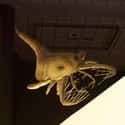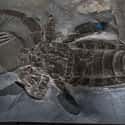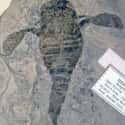-
(#10) No One Is Sure Why They Got So Big
There are competing theories as to why ancient sea scorpions grew to be so large. Some say it is because there was a lot more oxygen in the atmosphere during the Ordovician period when eurypterids lived, which may have allowed insects and arthropods to become gigantic compared to their surviving evolutionary descendants.
Another theory postulates eurypterids had to evolve so they could continue to hunt their prey. Since their food was also evolving, they needed to get bigger to deal with harder shells. The lower gravity caused by the displacement of mass in water may have also contributed to their gargantuan size.
-
(#2) They Adapted To Live On Land And In Water
Some eurypterids had the ability to breathe while in water and on land. One of the first animals to make the evolutionary leap from sea to shore, they periodically left the safety of their shells. Like other arthropods, these sea scorpions had exoskeletons that they could shed.
Since eurypterids' legs were designed for swimming, when they were on land, they likely had a difficult time moving around. The water might have restricted larger varieties because their legs could not support their body weight on land.
-

(#8) They Were Perhaps Fierce Predators
Given the creatures' size and claws that protruded in front of their mouths, experts once thought eurypterids were top predators. They had the advantage of being able to quickly swim through the water, as they relied on fish and other sea life for sustenance.
This hypothesis appears more likely to be applicable before eurypterids' prey began to adapt and develop better defense mechanisms. Other research suggests eurypterids were bottom feeders that preyed on soft-skinned animals along the sea bed. Despite their massive size, later generations of eurypterids lacked good eyesight, making it difficult to swiftly pick off other creatures.
-
(#1) Their Claws Could Be Over 19 Inches Long
The Jaekelopterus rhenaniae species of eurypterids, nicknamed "Jake," had a pincer claw measuring a half-meter. For those who don't follow the metric system, that is over one-and-a-half feet long! Paleontologist Markus Poschmann found the fossilized claw in a quarry in Germany, almost inadvertently while on a random hunt for other fossils in 2010.
Poschmann's crew was removing sediment from ancient slabs of siltstone at the bottom of a body of water, and Poschmann noticed "a dark patch of organic matter." This matter turned out to be an appendage used to gouge fish and snatch up other sea life. Some think such fish developed thicker exoskeletons as an evolutionary response to Jake's claws and hunting style.
-
(#5) They Weren't Really Scorpions
While sea scorpions and present-day scorpions resemble one another and probably share a common ancestor, the truth is they aren't scorpions at all. Scorpions are most well-known for their stingers. As for sea scorpions, their claws are similar to modern-day scorpions, and they also have tails called telsons.
On the contrary, however, the sea scorpion's stingers did not produce venom.
-
(#6) They Lived In Prehistoric Craters
A large fossil bed containing the remains of over 100 eurypterids was discovered in a meteorite impact crater near Decorah, IA. Such craters were created about 460 million years ago when the planet was pelted with incoming meteorites.
As the millennia passed, these craters filled up with water and became seas that offered an ideal habitat for sea scorpions.
New Random Displays Display All By Ranking
About This Tool
The sea scorpion is a kind of ancient sea creature with a body length of 1 to 2 meters. It existed on the earth 500 million years ago and a giant among arthropods. Fossils of giant sea scorpions have been found in the United Kingdom and the United States, the largest and oldest sea scorpion fossil ever discovered was unearthed in Iowa.
The sea scorpions have sharp and slender arm-length claws that can grab the prey and push it into their mouths. This is obvious that the sea scorpion is a very aggressive animal. You could learn 13 facts about the sea scorpion with this random tool.
Our data comes from Ranker, If you want to participate in the ranking of items displayed on this page, please click here.














